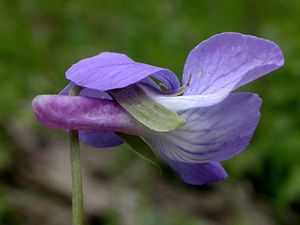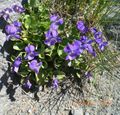Viola adunca
- Scientific Name: Viola adunca
- Family: Violaceae
- Common Names: early blue violet, blue violet, western dog violet
- Codon:VIOADU
Contents
Taxonomy
| Scientific classification | |
|---|---|
| Kingdom: | Plantae |
| Subkingdom: | Viridiplantae |
| Phylum: | Tracheophyta |
| Subphylum: | Spermatophytina |
| Class: | Magnoliopsida |
| Subclass: | Rosanae |
| Order: | Malpighiales |
| Family: | Violaceae |
| Genus: | Viola L. |
| Species: | Viola adunca Sm. |
Description
Perennial from short to long, slender rhizomes. Usually stemless in the early part of the season, later developing aerial stems up to 10 cm tall. Starts to flower early in the growing season. Leaves generally oval to heart-shaped, hairy to hairless, blades to 3 cm long with fine round-toothed margins. Stipules reddish-brown or with reddish-brown flecks, narrowly lance-shaped margins slender-toothed or somewhat ragged. Flowers to 1.5 cm long, with a slender spur half as long as the lowest petal, petals blue to deep violet, the lower three often white at base and purple-pencilled, the lateral pair white-bearded. Fruits small capsules opening explosively by three valves[2]
Bloom Period
April-August[3]
Distribution
Grasslands, open forests, rocky slopes, dry to damp meadows, lowland to alpine; widespread, Alaska to California, both sides of Cascades, east to Atlantic.[4]
Habitat
Dry to moist meadows, open woods, grasslands and open, disturbed ground from lowlands to near timberline[2]
Uses
Ecological: Key food species for the larvae of the silverspot butterfly.
Landscaping: Native violets "can produce the right substitute with a restrained beauty" to exotics such as pansies. "This is an easy, dependable and lovely plant for rather dry, open woods or lower reaches of the rockery in sun or partial shade." [5]
Propagation
Cold moist stratification improves germination. To stratify outdoors, sow in container from November through January, allow exposure to rain, do not protect from frost, until after germination. Best to sow several seeds into a single tray, pluck out and transplant individually in the spring. Emergence usually occurs once soil has warmed in April, sometimes May. Seed should be brown in color. Buff or pale colored seed indicates immature development.[6]
Photo Gallery
References
- ↑ Integrated Taxonomic Information System. Retrieved from https://www.itis.gov/servlet/SingleRpt/SingleRpt?search_topic=TSN&search_value=22032#null
- ↑ 2.0 2.1 MacKinnon, A., Pojar, Jim, & Alaback, Paul B. (2004). Plants of the Pacific Northwest coast : Washington, Oregon, British Columbia & Alaska (Rev. ed.). Vancouver: Lone Pine Pub.
- ↑ WTU Herbarium, Burke Museum, & University of Washington. Retrieved from https://biology.burke.washington.edu/herbarium/imagecollection/taxon.php?Taxon=Viola%20adunca
- ↑ Hitchcock, C. L., Cronquist, A., Giblin, D., & Legler, B. et al. (2018). Flora of the Pacific Northwest: an illustrated manual. Seattle: University of Washington Press
- ↑ Kruckeberg, A. (1996). Gardening with native plants of the Pacific Northwest (2nd ed., rev. and enl. ed.). Seattle : Vancouver: University of Washington Press ; Greystone Books.
- ↑ Cascadia Prairie Oak Partnership. Retrieved from https://www.cascadiaprairieoak.org/documents/PAD08PROFILESdblpages.pdf






